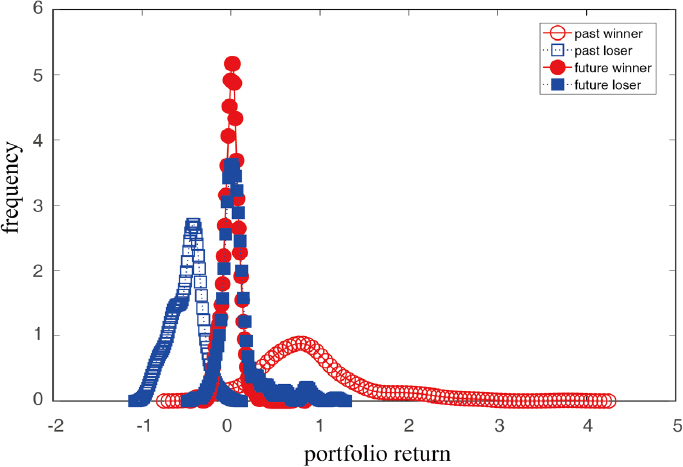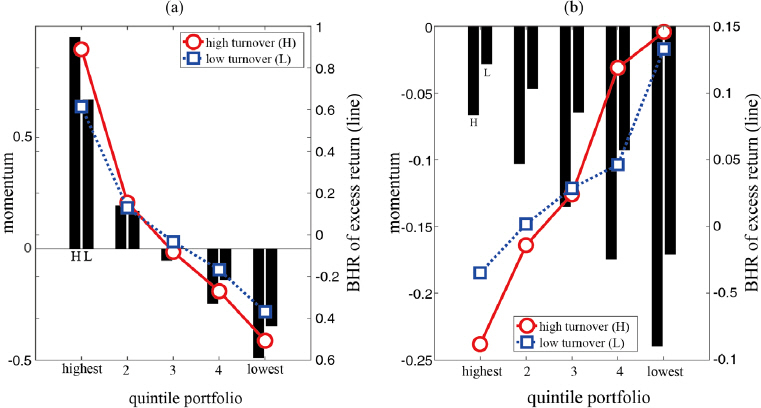Amihud, Y, 2002, Illiquidity and Stock Returns: Cross-section and Time-series Effects,
Journal of Financial Markets, Vol. 5, pp. 31-56.

Ang, A, J. Chen, and Y Xing, 2006, Downside risk, Review of Financial Studies, Vol. 19 (4), pp. 1191-1239.
Asem, E, and G. Y Tian, 2010, Market Dynamics and Momentum Profits,
Journal of Financial and Quantitative Analysis, Vol. 45, pp. 1549-1562.

Barber, B, and T Odean, 2008, All that Glitters: The Effect of Attention and News on the Buying Behavior of Individual and Institutional Investors,
Review of Financial Studies, Vol. 21, pp. 785-818.

Barberis, N, N Shleifer, and R Vishny, 1998, A Model of Investor Sentiment,
Journal of Financial Economics, Vol. 49, pp. 307-343.

Blitz, D, J Hujj, and M Martens, 2011, Residual Momentum,
Journal of Empirical Finance, Vol. 18, pp. 506-521.

Brown, K. C, and W. V. Harlow, 1988, Market Overreaction: Magnitude and Intensity,
Journal of Portfolio Management, Vol. 14, pp. 6-13.

Chae, J, and Y Eom, 2009, Negative Momentum Profit in Korea and its Sources,
Asia-Pacific Journal of Financial Studies, Vol. 38 (2), pp. 211-236.

Chaves, D. B, 2016, Idiosyncratic Momentum:U.S. and International Evidence,
Journal of Investing, Vol. 25 (2), pp. 64-76.

Choe, H, R. C. Kho, and R. M Stulz, 1999, Do Foreign Investors Destabilize Stock Market? The Korea Experience in 1997,
Journal of Financial Economics, Vol. 54, pp. 227-264.

Chui, A. C. W., S Titman, and K. C. J Wei, 2000, Momentum, Legal Systems and Ownership Structure: An Analysis of Asian Stock Markets, SSRN, https://dx.doi.org/10.2139/ssrn.265848.

Chui, A. C. W., S Titman, and K. C. J Wei, 2010, Individualism and Momentum around the World,
Journal of Finance, Vol. 65 (1), pp. 6361-392.

Cooper, M. J, R. C Gutierrez Jr, and A Hameed, 2004, Market States and Momentum,
Journal of Finance, Vol. 59, pp. 1345-1365.

Corwin, S, and J Coughenour, 2008, Limited Attention and the Allocation of Effort in Securities Trading, Journal of Finance, Vol. 63, pp. 3031-3067.
Daniel, K, and T. J Moskowitz, 2016, Momentum Crashes,
Journal of Financial Economics, Vol. 122, pp. 221-247.

Daniel, K, D Hirshleifer, and A Subrahmanyam, 1998, Investor Psychology and Security Market under- and Overreactions,
Journal of Finance, Vol. 53 (6), pp. 1839-1885.

Datar, K, N. Y. Naik, and R Radcliffe, 1998, Liquidity and Asset Returns:An Alternative Test,
Journal of Financial Markets, Vol. 1, pp. 203-220.

Du, D, Z Huang, and B. S Liao, 2009, Why is there no Momentum in the Taiwan Stock Market?,
Journal of Economics and Business, Vol. 61, pp. 140-152.

Eom, C, 2012, Re-examination on Cross-section of Expected Stock Returns under Up/Down Market Conditions, Asian Review of Financial Research, Vol. 25 (4), pp. 599-639.
Eom, C, W. B Lee, and J. W Park, 2014, A Reexamination of the Size Effect in the Korean Stock Market, Korean Journal of Financial Management, Vol. 31 (3), pp. 113-151.
Eom, C, W. B Lee, and J. W Park, 2019, The Relationship between Conditional Volatility and Stock Return, and Characteristics of Stock Return Volatility: A Disaggregated Approach in the Korean Stock Market, Korean Journal of Financial Management, Vol. 36 (3), pp. 1-28.
Eom, C, W. B Lee, R. S Park, U Chang, and J. W Park, 2014, A Study on the Relationship between Idiosyncratic Volatility and Stock Returns in the Korean Stock Markets, Korean Journal of Financial Studies, Vol. 43 (4), pp. 735-784.
Eom, Y, 2013, Momentum Profits and Firm Size, Korean Journal of Financial Studies, Vol. 42 (5), pp. 901-927.
Fama, E. F, and K. R. French, 1992, The Cross-section of Expected Stock Returns,
Journal of Finance, Vol. 47, pp. 427-465.

Fama, E. F, and K. R. French, 1993, Common Risk Factors in the Returns on Stocks and Bonds,
Journal of Financial Economics, Vol. 33, pp. 3-56.

Festinger, L, A Theory of Cognitive Dissonance, Stanford University Press 1964, 1st ed. 1957.
Grinblatt, M, and B Han, 2005, Prospect Theory, Mental Accounting, and Momentum,
Journal of Financial Economics, Vol. 78, pp. 311-339.

Hameed, A, and Y Kusnadi, 2002, Momentum Strategies: Evidence from Pacific Basin Stock Markets,
Journal of Financial Research, Vol. 25 (3), pp. 383-397.

Hanauer, M, 2014, Is Japan Different?Evidence on Momentum and Market Dynamics,
International Review of Finance, Vol. 14 (1), pp. 141-160.

Hong, H, and J Stein, 1999, A Unified Theory of Underreaction, Momentum Trading, and Overreaction in Asset Markets,
Journal of Finance, Vol. 54, pp. 2143-2184.

Hou, K, L Peng, and W Xiong, 2009, A Tale of Two Anomalies: The Implications of Investor Attention for Price and Earning Momentum, SSRN, https://dx.doi.org/10.2139/ssrn.976394.
Jegadeesh, N, 1990, Evidence of Predictable Behavior of Security Returns,
Journal of Finance, Vol. 45, pp. 881-898.

Jegadeesh, N, and S Titman, 1993, Returns to buying Winners and Selling Losers: Implications for Stock Market Efficiency,
Journal of Finance, Vol. 48 (1), pp. 65-91.

Kahneman, D, and A Tversky, 1979, Prospect Theory: An Analysis of Decision under Risk,
Econometrica, Vol. 47, pp. 263-291.

Kahneman, D, Attention and Effort, Prentice Hall, New Jersey:1973.
Kang, J, K Kown, and H. J Park, 2014, Momentum and Foreign Investors: Evidence from the Korean Stock Market, Emerging Markets Finance &Trade, Vol. 50 (5), pp. 131-147.
Karlsson, N, G Loewenstein, and D Seppi, 2009, The Ostrich Effect: Selective Attention to Information,
Journal of Risk Uncertainty, Vol. 38, pp. 95-115.


Kho, B. C, 1997, Premium Risk and Profitability of Relative Strength Strategies, Korean Journal of Financial Management, Vol. 14 (1), pp. 1-21.
Kim, C. S, 2000, On the Efficiency of the Market KOSDAQ, Korean Journal of Financial Studies, Vol. 27 (1), pp. 331-361.
Kim, K, and J Byun, 2011, Studies on Korean Capital Markets from the Perspective of Behavioral Finance, Asian Review of Financial Research, Vol. 24 (3), pp. 953-1050.
Kim, S, 2012, A Study on the Profitability of the Trading Strategies Using Past Returns, Asian Review of Financial Research, Vol. 25 (2), pp. 203-246.
Lee, C. M. C, and B. Swaminathan, 2000, Price Momentum and Trading Volume,
Journal of Finance, Vol. 55 (5), pp. 2017-2069.

Lee, D, and J Cho, 2014, Stock Price Reactions to News and the Momentum Effect in the Korean Stock Market,
Asia-Pacific Journal of Financial Studies, Vol. 43, pp. 556-588.

Lin, C, K. C Ko, Z. X Feng, and N. T Yang, 2016, Market Dynamics and Momentum in the Taiwan Stock Market,
Pacific-Basin Finance Journal, Vol. 38, pp. 59-75.

Lo, A. W, and A. C. MacKinlay, 1990, When are Contrarian Profits Due to Stock Market Overreaction?,
Review of Financial Studies, Vol. 3 (2), pp. 175-205.

Newey, W. K, and K. West, 1994, Automatic Lag Selection in Covariance Matrix Estimation,
Review of Economic Studies, Vol. 61, pp. 631-653.


Park, K. I, and C. Jee, 2006, Contrarian Strategy Based on Past Stock Return and Volatility, Korean Journal of Financial Management, Vol. 23 (2), pp. 1-25.
Pashler, H, and J Johnston, H. Pashler(Ed.), Attentional Limitations in Dual-Task Performance, Attention, Psychology Press, 1998.
Sedlacek, T, Economics of Good and Evil, The Quest for Economic Meaning from Gilgamesh to Wall Street, Oxford University Press, 2011.
Shalen, C. T, 1993, Volume Volatility and the Dispersion of Beliefs,
Review of Financial Studies, Vol. 6 (2), pp. 405-434.


Shefrin, H, and M Statman, 1985, The Disposition to Sell Winners Too Early and Ride Losers Too Long: Theory and Evidence,
Journal of Finance, Vol. 40, pp. 777-790.

Statman, M, S Thorley, and K Vorkink, 2006, Investor Overconfidence and Trading Volume,
Review of Financial Studies, Vol. 19 (4), pp. 1531-1565.













